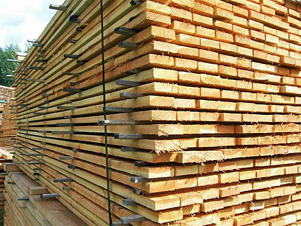Softwood Duties to Dampen Outlook for Canada's Wood Products Industry
Canada's wood products manufacturers will see pre-tax profits shrink from $1.8 billion in 2016 to $1.4 billion this year and $1.1 billion in 2018, as the United States issues duties averaging 30% on Canada's softwood lumber.
"The Canadian wood products industry's financial performance is forecast to deteriorate in the years ahead as import duties cut into shipments to the U.S. and act as a drag on industry growth," said Michael Burt, director, Industrial Trends, The Conference Board of Canada. "Revenues that would previously flow into the pockets of Canadian lumber producers will now be diverted to U.S. Customs and Border Protection in the form of cash deposits. While Canadian producers will not bear the total cost of the new duties, revenues will be impacted and revenue growth is not projected to keep pace with cost increases in the near term."
Highlights of the report include:
- Wood products manufacturers can expect to see pre-tax profits drop to $1.4 billion this year and $1.1 billion in 2018.
- Softwood lumber duties will cause production within the industry's sawmills segment to contract in 2017.
- Non-lumber production will help the industry manage GDP growth of 0.3% this year.
- Wood products manufacturers will continue to depend on the upturn in the U.S. housing market to drive production growth.
The sawmills segment, the largest contributor to the industry's production, is forecast to see exports contract in 2017, as U.S. lumber duties result in less profitable production being scaled back. Substantial employment losses are also anticipated in this segment, with a net loss of 1,100 workers forecast for the segment in 2017.
It is only due to a healthy outlook for non-lumber production (e.g., veneer, plywood, and other millwork) that the industry will expand, as GDP manages growth of 0.3% this year and 1.8% in 2018.
Recent increases in lumber prices support the notion that Canadian producers will be able to pass along a portion of the cost to consumers. Lumber prices are now 20% higher compared with one year ago, as markets have begun to price in the effects of lumber duties. In addition, current market conditions suggest that upward pressure on lumber prices could continue as demand conditions south of the border improve and drive production growth.
Fortunately, U.S. housing starts are expected to grow from 1.2 million in 2016 to 1.7 million by 2018. In comparison, housing starts in Canada are expected to fall from 199,000 starts to 190,000 starts during the same period. And, while U.S. lumber duties will undoubtedly drive producers to explore other export markets, the ability to target these markets competitively will remain a challenge for many producers, particularly those with long-established logistical ties to the U.S. market.
"Although the U.S. remains the dominant destination for Canadian wood products exports, the new trade restrictions could encourage a further pivot toward Asian markets, particularly China where growing demand for wood products recently pushed imports of logs and lumber by this fiber-poor country to their highest level on record," said Burt.
TAPPI
http://www.tappi.org/
 Following its strongest showing in three years, production growth in Canada's wood products industry is expected to moderate significantly in 2017 due to the incoming U.S. trade restrictions on Canadian softwood lumber, according to The Conference Board of Canada's Canadian Industrial Outlook: Canada's Wood Products Manufacturing Industry.
Following its strongest showing in three years, production growth in Canada's wood products industry is expected to moderate significantly in 2017 due to the incoming U.S. trade restrictions on Canadian softwood lumber, according to The Conference Board of Canada's Canadian Industrial Outlook: Canada's Wood Products Manufacturing Industry.